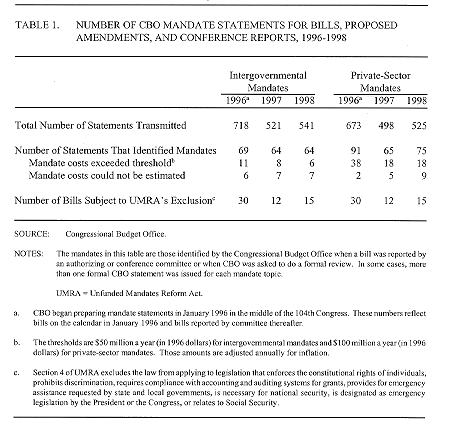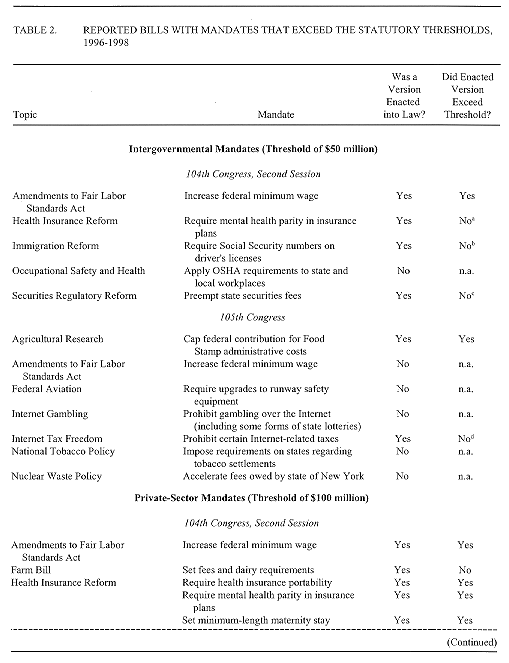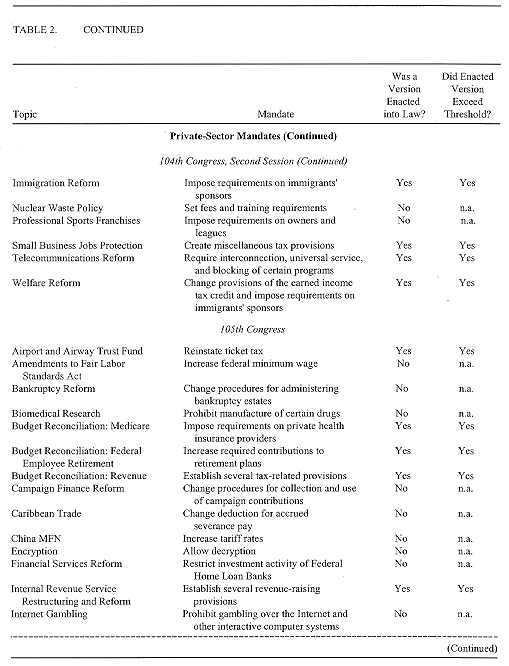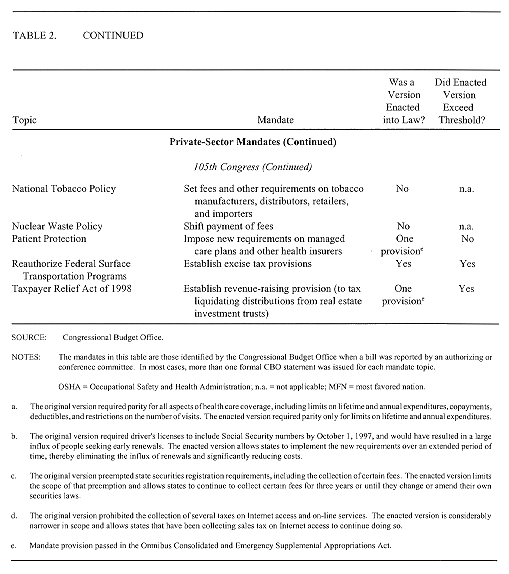Hearings of the
Subcommittee on Rules and Organization of the House
H.R. 350 - Mandates Information Act of 1999
We think UMRA has worked as intended. The Congress has more information about the effects of legislation on other levels of government and the private sector than it would have without the act. In a number of instances, CBO has assisted legislative staff by identifying mandates in draft legislation and, particularly with respect to intergovernmental mandates, has seen the language changed in final versions to reduce or eliminate the costs of the mandates.
CBO has prepared almost 1,800 mandate cost statements during the first three years of UMRA. Twenty-six of those statements identified intergovernmental mandates (as defined by the act) with costs greater than the $50 million a year threshold. Seventy-four reported private-sector mandates with costs exceeding their $100 million annual threshold. Few of those mandates were enacted—just two intergovernmental mandates and 17 private-sector mandates during the three-year period. It is impossible to know what those numbers would have been in the absence of UMRA. But we—and most other observers—believe that the act has contributed to cutting the number and cost of intergovernmental mandates.
H.R. 350 would amend UMRA by requiring that CBO provide expanded information about the effects of legislation on the private sector and by redefining an intergovernmental mandate as it applies to large entitlement programs.
With respect to the first proposed change, CBO already provides information about the effects of legislation beyond the immediate mandate costs when those effects are significant and the information can be obtained. We will continue to do so even without this change in the law. However, there is a limit to the additional information that CBO can furnish. The main constraints are the short time available to conduct our analyses and the lack of data or existing studies on the affected sectors of the economy. In addition, CBO's analyses are often made difficult because the costs depend on regulations that will be developed after the legislation is enacted. (The Congress has an opportunity to review major regulations before they take effect under the provisions of the Small Business Regulatory Enforcement Fairness Act. The availability of proposed regulations may make it easier for agencies to estimate costs at that time.)
With respect to changing the definition of a mandate for large entitlement programs (such as Medicaid), the proposed redefinition would cause virtually any change to those programs that capped or cut funding or imposed new conditions on state or local governments to be considered a mandate. To avoid being subject to procedural challenges, such changes would have to be paired with new cost-saving options or a relaxation of existing grant conditions. From CBO's perspective, bills would probably become more complicated and their associated costs more difficult to estimate.
HOW WELL HAS UMRA WORKED?
From CBO's vantage point, UMRA has been quite effective. Both the demand for and the supply of information about the costs of federal mandates have increased since it took effect. Over the past three years, CBO has prepared mandate cost statements for virtually all bills reported by authorizing committees. We have also provided mandate statements for many proposed floor amendments and some conference committee reports.
Before proposed legislation is marked up, committee staffs and individual Members are increasingly requesting our analysis about whether the legislation would create any new federal mandates and, if so, whether their costs would exceed the thresholds set by UMRA. (Those thresholds are $50 million per year for intergovernmental mandates and $100 million per year for private-sector mandates, indexed annually for inflation.) In many instances, CBO is able to inform the sponsor about the existence of a mandate and provide informal guidance on how the proposal might be restructured to eliminate the mandate or reduce its cost. That use of UMRA early in the legislative process may not involve the law’s formal procedural hurdles, but it appears to have had an effect on the number and burden of intergovernmental mandates in enacted legislation.
The Internet Tax Freedom Act (S. 442, H.R. 1054, and other bills of the 105th Congress) is a good example of this interaction. CBO worked with both supporters and opponents of the bills to identify mandates and their costs before the bills were marked up by full committees. CBO determined that early versions of the proposal contained an intergovernmental mandate (a preemption of state authority to tax Internet services) that would impose costs exceeding the threshold. Over a two-year period, CBO continued to provide mandate cost estimates as the bills worked their way through the legislative process. The Internet Tax Freedom Act became law on October 19, 1998, and although it still contained an intergovernmental mandate, that mandate had been narrowed so that it would not result in costs above the threshold.
Number of Mandate Statements Prepared Since 1996
Since the beginning of 1996, CBO has examined almost 1,800 bills and amendments and prepared mandate cost statements for them (see Table 1). About 11 percent of those bills and amendments (197) contained intergovernmental mandates, and about 1.5 percent (25) had mandate costs exceeding the $50 million threshold. In addition, of the bills and amendments that CBO examined for private-sector mandates, about 14 percent (231) contained such mandates, and around 4 percent (74) had costs over the $100 million threshold. CBO's third annual report on UMRA, An Assessment of the Unfunded Mandates Reform Act in 1998, contains additional statistics and details on the mandates that CBO identified during UMRA's first three years.
Mandates in Enacted Legislation
Another way to evaluate the impact of UMRA is to review the number of mandates that have actually been enacted since January 1996. Because CBO prepares statements on each bill reported in the House and Senate, and because each body may consider the same basic mandate in more than one piece of legislation, the number of mandates in legislation is less than the number of statements prepared. The 26 statements that CBO provided for legislation containing intergovernmental mandates above the cost threshold contained only 12 distinct mandates.
Of those 12 intergovernmental mandates, only two—an increase in the minimum wage and a reduction in the federal funding available for administrative expenses of the Food Stamp program—were enacted in a form that will impose costs on state and local governments of more than $50 million in a year (see Table 2). In the 10 remaining cases, the legislation was not enacted or was passed with amendments that lowered the costs below the threshold.
CBO also reviewed the laws enacted in 1997 and 1998 to determine whether they contained intergovernmental mandates for which CBO had not prepared a mandate statement during the legislative process. A small number of laws—about a dozen over the two-year period—contained such mandates, which were added after the bills were reported by committee (the point at which CBO's mandate statements are required by law). In such cases, CBO provides cost statements only when requested. None of those mandates, however, will impose significant costs on state or local governments.
The track record for private-sector mandates is a bit different. In the second session of the 104th Congress, nine of the 11 reported bills with private-sector mandates above the cost threshold were passed. Only one of those mandates—the dairy provisions of the farm bill—was amended on the floor to reduce mandate costs below the $100 million limit. Two bills with significant private-sector mandates —involving nuclear waste policy and sports franchises—were not enacted into law. In the 105th Congress, eight private-sector mandates originally identified as having costs above the threshold were enacted. One, which began as part of the patient protection bills, was enacted in a form that had costs below the threshold. Five others were in bills that either reinstated excise taxes or otherwise raised revenue to maintain the budget neutrality of the bill containing the mandate. The remaining two enacted mandates involved new requirements on health insurance providers and a required increase in retirement contributions by federal employees.
PROPOSALS IN H.R. 350
Consideration of Private-Sector Mandates
Section 4 of H.R. 350 would establish a point of order against considering bills that contain private-sector mandates with costs over the $100 million threshold. The bill as introduced contains some ambiguity about whether the point of order would apply if federal funding was provided to offset the cost of the mandate. Based on conversations with committee staff, CBO believes that the drafters intended for the point of order to apply regardless of whether such funding was provided. (In the case of intergovernmental mandates, by contrast, the existing point of order against considering mandates with costs above the threshold does not apply if sufficient funding is provided.) The new point of order could be overcome in both Houses by a majority vote, just like the point of order on intergovernmental mandates. Thus, the point of order might not be a significant obstacle to a bill's passage, but it would raise the stakes in deliberating private-sector mandates. It could also increase the demand for cost information earlier in the legislative process as drafters tried to avoid being subject to it.
Section 4 would also require CBO to provide expanded cost information for private-sector mandates above the threshold. Specifically, CBO would have to analyze the effect of the proposed mandates on consumers, workers, and small businesses, including any disproportionate impact on particular regions and industries. Those analyses would look at the effects on consumer prices; workers' wages, benefits, and employment opportunities; and the profitability of small businesses. Such effects occur when the costs of a mandate imposed on one party are passed along to other parties in the form of higher prices for finished goods or lower prices for intermediate inputs, including lower wages for workers. Those effects go beyond the direct costs of complying with a federal mandate, which CBO is now required to estimate.
CBO already includes information about significant economic effects in some of its cost statements for private-sector mandates when sufficient time and data are available. For example, CBO's analysis of proposed increases in the minimum wage included quantitative estimates of the effect on employment levels of low-wage workers. Economists have long studied how employers would respond to a higher minimum wage, and CBO used those studies to produce a range of estimates of the employment effects of the mandate. CBO has also provided qualitative statements about economic effects when some general information is available but detailed studies are not. In our mandate statement on the Consumer Bankruptcy Reform Act, for example, we described how most of the costs of the mandate—which is imposed on attorneys—would be passed on to bankruptcy estates.
The more time we have to analyze proposed mandates, and the more data and scholarly work available on the topic being analyzed, the more information we can give the Congress about the economic effects of a proposed mandate beyond its direct costs. But depending on the specific mandate, furnishing significantly more information than we now provide may not be possible. As noted earlier, insufficient time, uncertainty about the content of regulations, and lack of data about the segment of the economy that would be affected by the mandate and how that segment operates may limit what CBO can say.
Redefining Intergovernmental Mandates
Section 5 of H.R. 350 would change the definition of an intergovernmental mandate as it relates to large entitlement grant programs. According to the act, programs affected by that definition are “federal programs under which $500 million or more is provided annually to state, local, and tribal governments under entitlement authority.” Those programs include Medicaid, Food Stamps, the federal foster care program, Temporary Assistance for Needy Families, Social Services Block Grants, Vocational Rehabilitation State Grants, Adoption Assistance and Independent Living, the JOBS program, and Child Support Enforcement.
By UMRA's current definition, an increase in the stringency of grant conditions or a decrease in federal funding for an entitlement program is a mandate only if the state or local governments that administer the program lack the flexibility to make changes to offset the new costs or decrease in funding. For most changes to large entitlement programs proposed over the past three years, CBO has estimated that states can avoid additional costs by reducing either the amount of money they spend or the services they provide at their option. The major exceptions have occurred with the Food Stamp and foster care programs, because states lack flexibility under current law to change those programs' parameters to offset higher costs.
Under H.R. 350, by contrast, changes to entitlement programs that imposed new conditions on states or decreased federal funding by an amount over the threshold would always constitute an intergovernmental mandate unless the bill making the change also gave states and localities new flexibility within the program to offset the new cost. Under that revised definition, the fact that states have significant flexibility under current law to reduce or eliminate optional services in most of those programs would not be considered in determining whether a mandate existed.
That change in the law would pose several challenges for both the Congress and CBO. To avoid the possibility of a point of order, the Congress would need to pair new grant conditions or funding caps with new cost-saving options or relaxations of existing grant conditions. That requirement would apply even for block-grant programs that already have few or no conditions attached to them, and even for programs (such as Medicaid) in which a large percentage of spending is up to the discretion of the states. CBO would need to estimate the cost of those new offsetting options—an activity that could be more difficult than the estimates now required.
Conclusion
In some cases, CBO might have trouble providing all of the information requested under H.R. 350. The legislative process often does not allow enough time for a comprehensive analysis of all relevant effects, so the results of an analysis may be less specific than desired. As the Congress requires additional CBO analyses for each reported bill, the amount of time needed to perform both those analyses and our core estimates of budget and mandate costs could lengthen. The changes to UMRA proposed in H.R. 350 would require CBO staff members to spend more time analyzing and writing about how mandated entities would react to the cost of a private-sector mandate. Furthermore, because bills proposing changes to entitlement programs would most likely be more complicated, CBO staff would have to spend more time estimating the costs associated with those bills.
Nevertheless, we expect that only a small number of bills would be affected, so we do not anticipate now that the increased duties imposed by H.R. 350 would necessarily require more resources or a diversion of existing resources from CBO's budget work. I can assure you that CBO will continue to do its best to provide the Congress with reliable information in a timely fashion.






